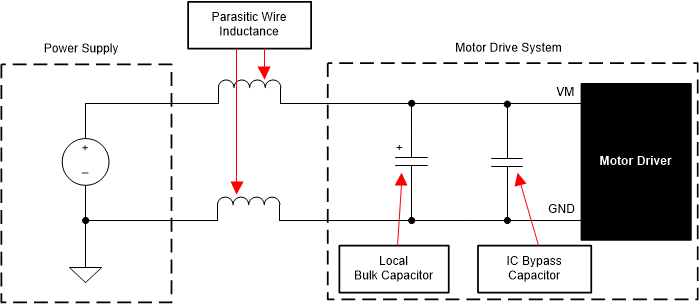SLVSH86A December 2023 – June 2024 MCT8314Z
PRODUCTION DATA
- 1
- 1 Features
- 2 Applications
- 3 Description
- 4 Device Comparison Table
- 5 Pin Configuration and Functions
- 6 Specifications
-
7 Detailed Description
- 7.1 Overview
- 7.2 Functional Block Diagram
- 7.3
Feature Description
- 7.3.1 Output Stage
- 7.3.2 PWM Control Mode (1x PWM Mode)
- 7.3.3 Device Interface Modes
- 7.3.4 AVDD Linear Voltage Regulator
- 7.3.5 Charge Pump
- 7.3.6 Slew Rate
- 7.3.7 Cross Conduction (Dead Time)
- 7.3.8 Propagation Delay
- 7.3.9 Pin Diagrams
- 7.3.10 Automatic Synchronous Rectification Mode (ASR Mode)
- 7.3.11 Cycle-by-Cycle Current Limit
- 7.3.12 Hall Comparators (Analog Hall Inputs)
- 7.3.13 Advance Angle
- 7.3.14 FG Signal
- 7.3.15
Protections
- 7.3.15.1 VM Supply Undervoltage Lockout (NPOR)
- 7.3.15.2 AVDD Undervoltage Lockout (AVDD_UV)
- 7.3.15.3 VCP Charge Pump Undervoltage Lockout (CPUV)
- 7.3.15.4 Overvoltage Protections (OVP)
- 7.3.15.5 Overcurrent Protection (OCP)
- 7.3.15.6 Motor Lock (MTR_LOCK)
- 7.3.15.7 Thermal Warning (OTW)
- 7.3.15.8 Thermal Shutdown (OTS)
- 7.4 Device Functional Modes
- 7.5 SPI Communication
- 8 Register Map
- 9 Application and Implementation
- 10Device and Documentation Support
- 11Revision History
- 12Mechanical, Packaging, and Orderable Information
Package Options
Mechanical Data (Package|Pins)
- RRW|24
Thermal pad, mechanical data (Package|Pins)
Orderable Information
9.4.1 Bulk Capacitance
Having an appropriate local bulk capacitance is an important factor in motor drive system design. It is generally beneficial to have more bulk capacitance, while the disadvantages are increased cost and physical size.
The amount of local capacitance needed depends on a variety of factors, including:
- The highest current required by the motor system
- The capacitance and current capability of the power supply
- The amount of parasitic inductance between the power supply and motor system
- The acceptable voltage ripple
- The type of motor used (brushed dc, brushless DC, stepper)
- The motor braking method
The inductance between the power supply and the motor drive system limits the rate current can change from the power supply. If the local bulk capacitance is too small, the system responds to excessive current demands or dumps from the motor with a change in voltage. When adequate bulk capacitance is used, the motor voltage remains stable and high current can be quickly supplied.
The data sheet generally provides a recommended value, but system-level testing is required to determine the appropriate sized bulk capacitor.
 Figure 9-15 Example Setup of Motor Drive System With External Power Supply
Figure 9-15 Example Setup of Motor Drive System With External Power SupplyThe voltage rating for bulk capacitors should be higher than the operating voltage, to provide margin for cases when the motor transfers energy to the supply.